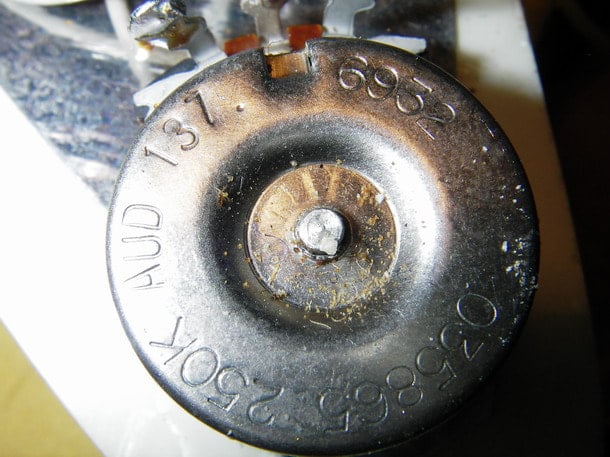SPLIT SHAFT VS SOLID SHAFT POTS
|
The very first Stratocasters were equipped with the same smooth full shaft (a.k.a. solid shaft) potentiometers used on the Telecaster. Unfortunately, the early Stratocaster polystyrene knobs were particularly brittle and had a brief life when mounted on the solid shaft pots. On the contrary, full shaft pots fits well the Telecaster. Indeed, Telecaster’s metal knobs had a small set screw, which was well tightened against the pot's solid shaft.
|
Since the plastic knobs of the Stratocaster could break even when they were pressed during the very first installation - or shortly after - by September 1954 Fender was forced to redesign knobs and replaced solid shafts with knurled split shaft pots.
Fender Stratocaster pots value was 250 kOhm, although few early guitars were fitted with 100 kOhm potentiometers.
Their shape has varied over the years: some were countersunk, while others featured a flat top.
The first pots used on the Stratocaster were made by Centralab (only in 1954) and Stackpole. In 1963 Leo Fender started to use also CTS (Chicago Telephone Supply) potentiometers. In 1966 a huge amount of CTS pots was bought and Fender took five years to use them all.
Since 1972 it has been possible, on order, to ground potentiometers and the switch by means of black plastic-coated wires.
Fender Stratocaster pots value was 250 kOhm, although few early guitars were fitted with 100 kOhm potentiometers.
Their shape has varied over the years: some were countersunk, while others featured a flat top.
The first pots used on the Stratocaster were made by Centralab (only in 1954) and Stackpole. In 1963 Leo Fender started to use also CTS (Chicago Telephone Supply) potentiometers. In 1966 a huge amount of CTS pots was bought and Fender took five years to use them all.
Since 1972 it has been possible, on order, to ground potentiometers and the switch by means of black plastic-coated wires.
HOW TO DATE FENDER POTS
Potentiometers used by Fender were stamped onto the back or sides of the pot with numbered codes which usually could give information about date of production, manufacturer and resistance values.
Pot’s codes were composed by the manufacturer code, followed by numbers which indicate week and year of production:
This code is not to be confused with the part reference numbers frequently stamped on the pot by the manufacturer for inventory purposes. For example, the full pot marking “021857 250K A 1376912” can be read:
“021857 250K” = the part number for a 250K audio pot
“1376942” = the dating code (CTS 12nd week of 1969)
Pot dates can be a useful tool in dating guitars, but it is important to keep in mind that this is the date of production of the potentiometer (not of the guitar), although they can give an idea of when the guitar was built. Fender sometimes took a very long time to use a batch of potentiometers, and they may be considerably older than the guitar itself. For example, in 1966 Fender bought a huge amount of CTS pots and took five years to use them all. It should be also considered that potentiometers in an older guitar may have been replaced.
Pot’s codes were composed by the manufacturer code, followed by numbers which indicate week and year of production:
- MMMYWW in the ‘50s
- MMMYYWW since the ‘60s
- “137” = CTS
- “304” = Stackpole
- “013” = Centralab
This code is not to be confused with the part reference numbers frequently stamped on the pot by the manufacturer for inventory purposes. For example, the full pot marking “021857 250K A 1376912” can be read:
“021857 250K” = the part number for a 250K audio pot
“1376942” = the dating code (CTS 12nd week of 1969)
Pot dates can be a useful tool in dating guitars, but it is important to keep in mind that this is the date of production of the potentiometer (not of the guitar), although they can give an idea of when the guitar was built. Fender sometimes took a very long time to use a batch of potentiometers, and they may be considerably older than the guitar itself. For example, in 1966 Fender bought a huge amount of CTS pots and took five years to use them all. It should be also considered that potentiometers in an older guitar may have been replaced.
TBX
|
The TBX tone control was first used on the Elite Stratocaster, and, later, on the 1987 American Standard and on the Plus Series.
This system allowed a player to cut treble and bass by rolling the tone knob, differently from the classic tone pot which cut only treble. Many believe that is an active system, but instead it was passive, as it cut and it did not amplify. Hence the different interpretations of the acronym: Treble Bass eXpander and Treble Bass Cuts (X). |
It operates as follows:
At the mid-point – the 5 setting – the TBX is equivalent to a normal tone control set all the way up, on 10.
- At settings counterclockwise from its mid-point clock-stop position, the TBX works just like a regular tone control because it cuts off high frequencies.
- At settings clockwise from its mid-point clock-stop position, the TBX cuts off bass frequencies, enhancing the higher resonant peak of the pickup.
At the mid-point – the 5 setting – the TBX is equivalent to a normal tone control set all the way up, on 10.








